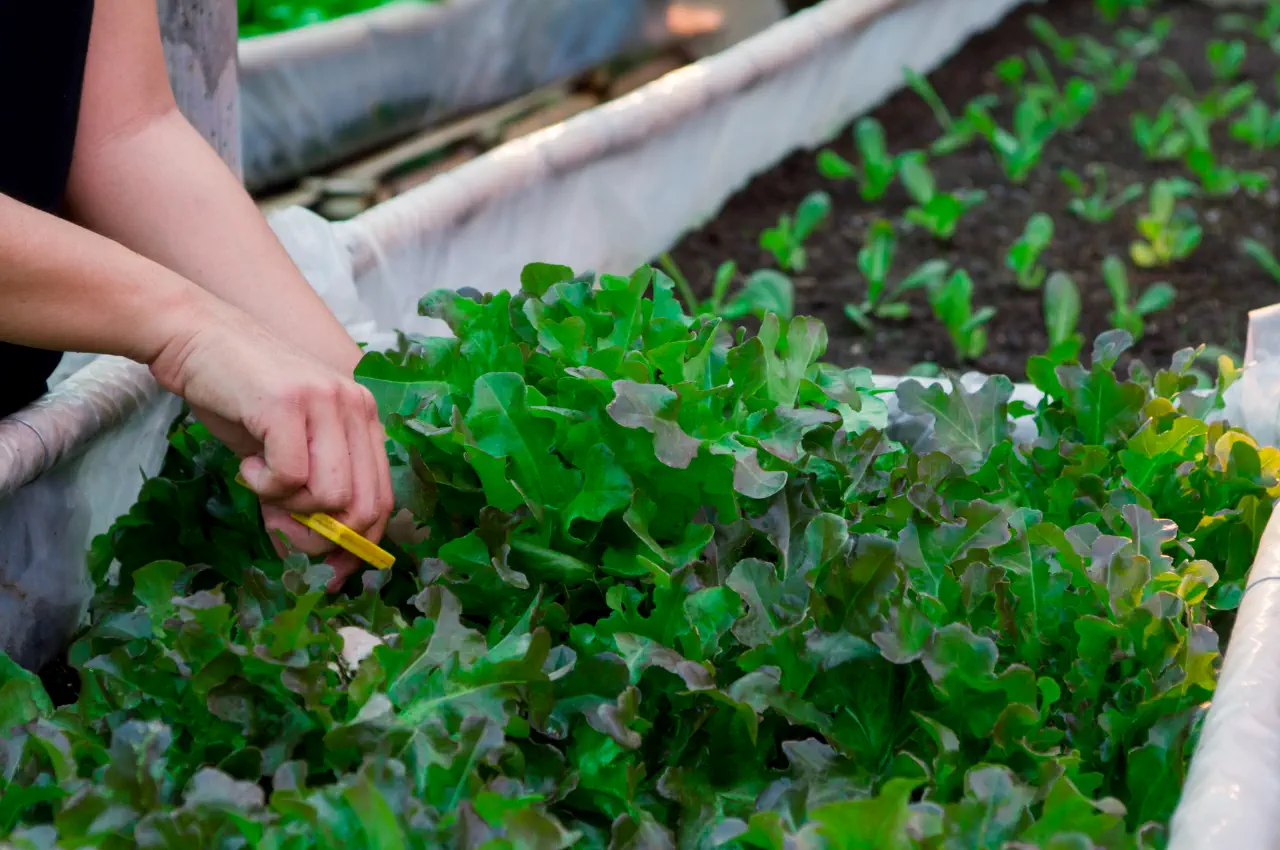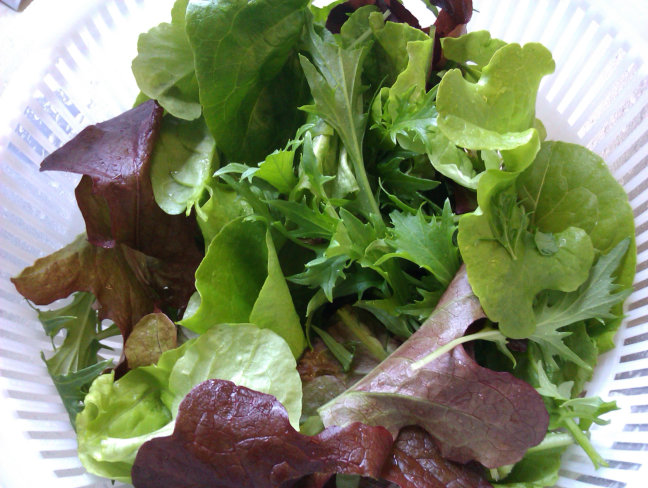Pak Choi is grown for its tasty leaves which are superb when added to stir fries and salads.
The taste is similar to that of mild cabbage and spinach and is a popular addition to many oriental dishes.

When we think of salads, we generally think of long, hot summer days and sultry evenings, when a cold meal is the only appropriate dish on the menu. And it doesn’t matter how you prepare it or present it, a salad is not a salad without lettuce, or is it?
Whilst lettuce has for generations been one of the main ingredients of the summer salad, this fresh, crisp and leafy treat can be adequately replaced or at least complimented by, a mixture of young and tasty salad leaves. So what is the difference? Well, taste, texture, colour and variety instantly springs to mind.
Think of a typical lettuce and you might imagine a head of tightly folded, crisp leaves around a tender blanched heart. A good example might be Iceberg or the popular Webbs Wonderful variety and nobody would disagree that these classic lettuce varieties look and taste great in any salad. However, these type of ‘head’ lettuces have a relatively long growing season when compared with many others because they are left to fully mature and then cut before they go to seed (bolt). Other varieties, such as the ‘loose leaf’ types are harvested over a quicker and more regular period, making them firm favourites with both growers and salad connoisseurs alike.
Although there are many varieties of lettuce and some with very different shaped leaves, including curly and oak shaped, they are all related. The loose leaf types include varieties such as Red Cos, Deronda and Lollo Rosso with their distinctive red foliage, which provides colour contrasts and textures to your salad. Other green types include Green Batavia, Lobjoits Green and Emocion. All of these can be harvested over a long period of time by picking a few outer leaves from each plant. If grown very close together they can be cut as required with scissors, when the leaves are young and tender, and will grow again providing at least 2 cm of stem is left in the ground. Cut and come again lettuce varieties can be purchased as a mixture, specially selected just for this purpose.
Premium dark green Batavian, ideal for growing outdoors.....
Av. Packet Contents : 25 seeds
Excellent Red Batavian, ideal for growing outdoors.....
Av. Packet Contents : 25 seeds
Premium Little Gem variety, good bolting resistance.....
Av. Packet Contents : 25 seeds
Green Batavia Lettuce variety suitable for use as a cut and come.....
Average Contents : 1000 seeds
Mix of Lettuce varieties suitable for use as a cut and come.....
Average Contents : 1.5g, approx 1000 seeds
While cut and come again lettuce consists of only lettuce varieties, cut and come again salads (salad leaves) may consist of several other plants such as mustard, mizuna, basil, parsley, rocket, spinach, sorrel, pak choi and many more. These plants can be grown individually and harvested over time, similar to loose leaf lettuce, however a more economical way to grow salad leaves is to purchase a selected seed mixture. This will allow you to plant beds of mixed salad, which can be harvested together, providing a variety of colours, textures and tastes for your salad bowl. A typical pack of mixed salad seeds might consist of spicy Greek Cress, Tatsoi, Mizuna, Pak Choi and Mustard. Grow these with a mix of loose leaf lettuce and you’ll never experience a dull salad, ever again.
Best Coriander for growing in Pots and Containers.....
Av. Packet Contents : 300 seeds
Lambs Lettuce is probably one of the most used salad......
Av. Packet Contents : 2.5g, approx 1250 seeds
A very prolific cropper, which will reform after cutting.....
Average Contents : 350 seeds
Red Lace is a very prolific cropper, mix with other salad leaves.....
Average Contents : 500 seeds
Cut and come again mixed salad seeds.....
Average Contents : 2g, approx 1200 seeds
Cut and come again mixed mustard seeds.....
Average Contents : 1000 seeds
Sorrel Red Veined is a great herb for mixing into salads.....
Av. Packet Contents : 300 seeds
Monterey is a versatile, but slower growing variety.....
Av. Packet Contents : 500 seeds
Both loose lettuce and mixed salads are very quick and easy to grow and can provide plenty of fresh leafy salad greens from March to September, if grown outdoors. For an all year round supply, grow indoors or under glass during the winter months and outdoors throughout the spring and summer.
Prepare planting beds in late autumn or early winter by incorporating plenty of organic matter. A well-drained soil is preferable and a warm sunny position will encourage plants to grow quickly. In early spring, rake over the beds, producing a fine, level tilth. Fill containers with a peat-free multipurpose growing compost or a mixture of clean, prepared soil and compost. Salad leaves can also be grown in large pots and in window boxes or growbags.
Seeds can be sown in pots or containers in a greenhouse from February, to be harvested in April. You can also sow seeds in containers under cloches in early March or directly into outdoor growing beds from Late March, right through to September. To ensure a constant supply of fresh salad leaves sow seeds every 2-3 weeks. When sowing in beds outdoors, such as on an allotment, use the edge of a hoe to draw a shallow drill about 1cm deep. Sow seeds thinly along the furrow, cover and water with a watering can and rose attachment. You can thin out the seedlings to around 2cm-3cm apart and use the surplus in salads, allowing the remainder to grow on before you begin regular cutting, so not allowing the plants to fully mature.
Whether you are growing your lettuce and salad leaves indoors or outdoors, use scissors to cut the leaves when they are about 10cm-15cm high, leaving 2cm-3cm above the surface to regrow. This task is best carried out in the early morning and before the sun has warmed the air. The cut salad leaves should then be washed gently in cold water and placed into plastic bags, where they will keep fresh in the fridge for a few days. Water the plants that have been cut and they will continue to grow, ready for cutting again in about 2-3 weeks. You may be able to repeat this process for up to 4 cuts.
Lettuce and salad leaves require copious amounts of water in order to grow quickly, so ensure the plants are kept well-watered. This is best carried out during the evening to prevent scorching by the sun. Young seedlings growing outdoors will inevitably attract the attention of slugs and snails during any wet and warm spring and summer periods. To help prevent your crop from being totally decimated, apply coarse grit between the rows or around plants, or use sawdust or broken eggshells. Beer traps also work well. It’s best to avoid using slug pellets if possible, as these can be harmful to pets and wildlife. Remove any dead or dying leaves to prevent the spread of grey mould and remove any weeds as soon as they appear.
Freshly picked from the raised bed, into the salad spinner and onto the plate - you can't beat it.....
This is a mix of Lettuce Mesclun Mixed, Rocket, Mizuna, and Spinach. Doesn't look too much different from those supermarket bags does it? And its a whole lot cheaper.

We sowed the Lettuce into large cell trays. A week before they were ready for planting, we sowed the Rocket and the Spinach direct into the raised beds. Then when we planted out the lettuce plants, we sowed the mizuna.
Result! Three weeks later and we are picking huge bowls of fresh salads, just add Tomatoes, some Cucumber, Pickled Onions and a bit of dressing and I think that's all you need. Plus, there's still time to be doing this yourself, you can grow in raised beds, or patio pots if you don't have an allotment.
All blog content on this page is copyright of Simplyseed and is not to be reproduced without prior written permission. ©